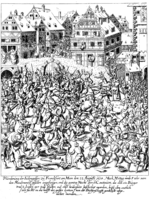
Photo from wikipedia
other nationalities were neither perpetrators of . . . nor bystanders to” the 1941 pogroms (p. 130). That “only” one out of ten localities experienced a pogrom is not surprising—pogroms… Click to show full abstract
other nationalities were neither perpetrators of . . . nor bystanders to” the 1941 pogroms (p. 130). That “only” one out of ten localities experienced a pogrom is not surprising—pogroms require collective action, and violence took place in the span of merely a few months, during which some Jews fled east, went into hiding, or died at the hands of the Germans. Nevertheless, the authors rightly caution against overstating the extent of violence against Jews on the eve of the Holocaust. Their large-n analysis of pogrom occurrence is a welcome contribution to the largely qualitative research on the Holocaust, and also a sober counterpoint to the heated debate about collaboration between local populations and occupying forces in Eastern Europe during World War II. The book challenges conventional accounts of ethnic violence and advises against extrapolating from a single case, such as the infamous July 1941 pogrom in the Polish town of Jedwabne (p. 65). The authors are also right to warn against viewing the pogroms exclusively as the product of widespread anti-Semitism (p. 130). At the same time, their thesis that Jews constituted a political threat fails to explain why the 1941 pogroms targeted Jews exclusively. The Ukrainian minority, for one, remained safe even though it outnumbered the Jewish minority, had strong nationalist aspirations, and eventually attacked Poles. The authors’ explanations for why Jews were the first victims—popular anti-Semitism and the German influence—seem somewhat ad hoc (p.112). Not least, pogroms themselves have been used as an indicator of anti-Semitism in the literature. In the penultimate chapter, Kopstein and Wittenberg briefly discuss the relevance of their argument for understanding anti-Jewish and intercommunal pogroms outside Poland and suggest promising avenues for future research. The book concludes by discussing ways to prevent interethnic violence. The authors contend that cultural assimilation of national minorities does not reduce the likelihood of pogroms. In their view, lowering the nationalist aspirations of ethnic minorities, reducing political polarization, or manipulating group identities to foster interethnic solidarity may be more effective. By using the power-threat theory to explain the 1941 pogroms, the authors show that theoretical insights from the literature on intergroup conflict in American and comparative politics can help us understand violence during World War II and the Holocaust, a phenomenon still somewhat peripheral to “mainstream” political science. One challenge is that existing applications of the power-threat theory are not limited to periods of state collapse. In the Polish case, the breakdown of state institutions in the summer of 1941 may have untied the hands of the local population, but pogroms against Jews had also occurred in previous periods. Relatedly, political dominance can be achieved by means short of pogroms, including political and economic discrimination; Polish Jews were subject to both well before the summer of 1941. Overall, Intimate Violence is an original and well-crafted study of interethnic competition on the eve of the Holocaust. The book advances our understanding of the microfoundations of ethnic conflict and challenges existing explanations of violence against Jews in twentiethcentury Eastern Europe. Kopstein and Wittenberg also assemble a fine-grained historical data set that could help address further questions about interethnic relations. As such, the book has much to offer scholars of intercommunal violence, nationalism, and Eastern European politics.
Journal Title: Perspectives on Politics
Year Published: 2018
Link to full text (if available)
Share on Social Media: Sign Up to like & get
recommendations!